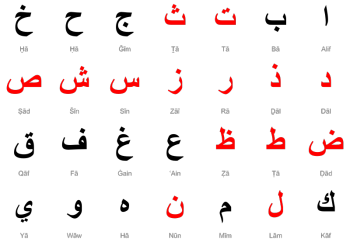Archive for February, 2009
Word formation and the use of Arabic dictionaries Posted by aziza on Feb 27, 2009
Most Arabic words are formed based on a root and certain patterns. The root typically consists of 3 letters, e.g. (ك ت ب). These letters can be used in a number of formations or patterns to make derivations or words that are related in meaning to the root, e.g. (كاتب)“writer”, (كتابة) “writing”, (كتاب) “book”, (مكتبة)…
Early Islamic history – the Rightly-Guided Caliphs Posted by aziza on Feb 26, 2009
Arab history is often identified with the history of Islam. Before Islam, Arabs lived as nomads in the deserts of the Arabian Peninsula. They lived as tribes where water sources were found, and they often worked in trade with other tribes and nations of Yemen and the Levant. At times, stronger tribes raided and acquired…
Calendars used in Arab countries Posted by aziza on Feb 23, 2009
In the Arab world, there are different calendars in use. The most common one is the Western calendar which is used in most countries of the world. The names of the months are different from one region to another. The following table gives 3 common ways of naming the twelve months of the year in…
Colloquial dialects in Arabic – Some features of Egyptian Colloquial Arabic Posted by aziza on Feb 17, 2009
Like most languages of the world, Arabic has many varieties. The most basic distinctions between different varieties of Arabic are based on medium, i.e. written or spoken, and geographical location. There is one main modern written variety of Arabic, namely Modern Standard Arabic or (MSA). This variety is used in writing and in formal talk…
The Arabic Sun and Moon Letters Posted by aziza on Feb 14, 2009
The Arabic alphabet (الأبجدية العربية) contains 28 letters, which are classified into 14 sun letters (الحروف الشمسية) and 14 moon letters (الحروف القمرية). This classification is based on the way these letters affect the pronunciation of the definite article (ال) at the beginning of words. The definite article is assimilated into the sun letters and…
Number Agreement in Arabic Posted by aziza on Feb 9, 2009
In English, words are either singular or plural, yet in Arabic, words can be singular (مفرد), dual (مثنى) or plural (جمع). Singular words refer to one person or thing only, dual nouns refer to two persons or things, while plural words refer to more than two. It is often the case that learners of Arabic…
Be My Friend! Posted by aziza on Feb 6, 2009
“Be My Friend!” (كن صديقى) is a beautiful poem by the famous Kuwaiti poet, critic and writer Suad al-Sabah. She was born in 1942 to the ruling family of Kuwait. She obtained a bachelor’s degree in Economics from Cairo University in 1973, and a PhD also in economics from Sari Guilford University in the UK in 1981…



